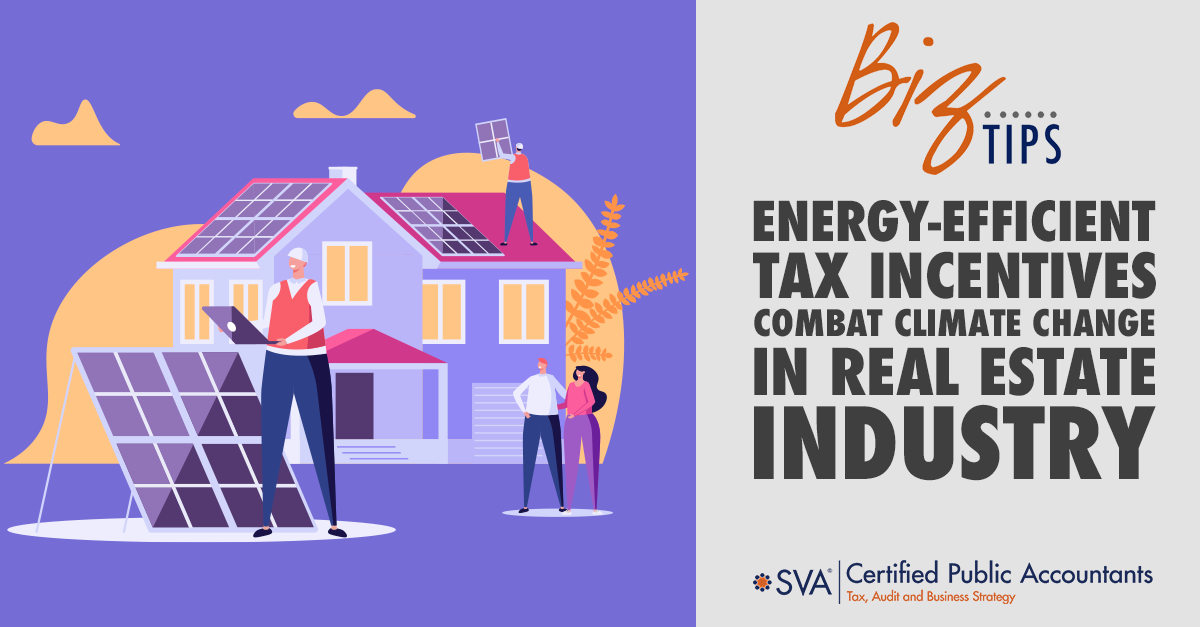Climate change is a huge problem, but damages to the environment vary by industry. The effect in the real estate industry ebbs and flows based on new buildings and the costs to upkeep current structures.
Today, the real estate industry may be more motivated to build energy-efficient buildings because of federal tax credits and deductions. In fact, several stakeholders in real estate, from owners to designers, could benefit from the provisions.
(Download Video Transcript)
2 Energy-Efficient Tax Incentives for Construction Projects
Sections 179D and 45L of the tax code provide energy-efficient incentives for both commercial and residential construction projects. When performed properly and verified by a third party, the tax incentives can be very beneficial for those building and remodeling in the real estate industry.
Section 179D: The Energy-Efficient Commercial Building Tax Deduction
Section 179D is the energy-efficient commercial building tax deduction. It was a temporary deduction that Congress made permanent at the end of 2020. It allows a tax deduction for up to $1.80 per square foot in a commercial, energy-efficient building. The energy improvements must result in at least a 50% energy savings. The $1.80 per square foot will be adjusted for inflation in the future.
Buildings that qualify for the deduction are at least four stories high and have energy-efficient improvements in the lighting system, heating, ventilation, air conditioning (HVAC), hot water system, or building envelope.
Any property built or system installed after 2005 (January 1, 2006) is eligible for the deduction. Two overarching groups can benefit from these deductions:
- Property owners can claim this deduction on prior year returns if they request a change in accounting methods.
- Architects, contractors and engineers who design government-owned energy-efficient buildings can claim a deduction through an allocation process with the government entity as part of their overall contract. Prior year deductions are also available.
A third-party contractor must verify that the building meets energy-efficient standards set by the American Society of Heating, Refrigerating, and Air-Conditioning Engineers (ASHRAE).
Buildings that might qualify so that designers (architects, contractors, and engineers) can claim the tax deduction include:
- K-12 Public Schools
- Military Buildings
- Public Parking Garages
- Airports
- Public Hospital Systems
- Government Buildings (city halls, courthouses, legislative buildings)
- Public Service Buildings (fire stations, prisons, police stations)
- Public Higher Education Buildings
The government building list is not unlimited, but it is broad.
Section 45L: Energy-Efficient Residential Tax Credit
Those who build residential properties can also get an energy-efficient credit of up to $2,000 per dwelling unit. The units must have been placed in service before December 31, 2021. Currently, the credit has expired, but there is new legislation being considered (Build Back Better Act, BBBA) to revive this credit.
The properties under 45L must be:
- Newly constructed or substantially renovated
- Meet certain energy reduction standards
- Certified by a qualified third party
- Used for residential purposes
- Three stories or less
Section 45L can still be used by amending prior returns if it was not used previously.
Qualifying properties range widely, from single-family homes to student housing and senior housing facilities. Even manufactured mobile home parks may qualify.
Potential Changes to Energy-Efficient Tax Incentives for Real Estate
President Biden put climate change high on his priority list when taking office. In November 2021, the House passed the BBBA, which dedicated $555 billion to combating climate change. The bill expands both Sections 179D and 45L. However, the Senate has not yet addressed the bill.
BBBA is not expected to pass in its entirety, but portions of it could move forward (after midterm elections later this year). The climate change piece that affects Sections 179D and 45L may be split so it can move forward as a separate bill.
Changes to Section 179D
The BBBA proposed some significant changes to Section 179D that would be effective through December 31, 2031. The most notable changes include the following:
- Tax-exempt entities will be able to allocate tax incentives to building designers and workers
- Use of a base rate and bonus rate, which is tied to the prevailing wage and apprenticeship requirements
- The base rate would be $0.50 per square foot for 25% energy efficiency, and the bonus rate would be an extra $1.00 per square foot of energy savings of 50% or more
- The bonus rate would be a sliding scale of up to $5.00 per square foot for 50% or higher energy savings
While it is unclear whether these changes will actually take effect, the differences here are significant, so those involved in commercial real estate should keep an eye on developments in this area.
Changes to Section 45L
Section 45L is currently expired, so the BBBA’s first significant change would be to revive it. An extension is proposed to run concurrently with the Section 179D expansion—through December 31, 2031.
Changes to Section 45L include also incorporating a base rate and bonus rate for multifamily homes. The base rate would be $500 and a bonus credit of up to $2,500.
Single-family homes would have a $2,500 credit, but Zero Energy Ready homes could include a credit of up to $5,000. Multifamily Zero Energy Homes include a base credit of $1,000 and a bonus credit of $5,000.
A Zero Energy Ready home is defined by the U.S. Department of Energy as “a high-performance home which is so energy efficient, that a renewable energy system can offset all or most of its annual energy consumption.”
(Download Video Transcript)
Get Help with Real Estate Tax Credits and Incentives
Although the expanded energy credits are not yet available, you may want to review prior returns to take advantage of changes with prior credits. Our team also plans to keep a close eye on this and other proposed tax changes.

© 2022 CPAContentPlus

